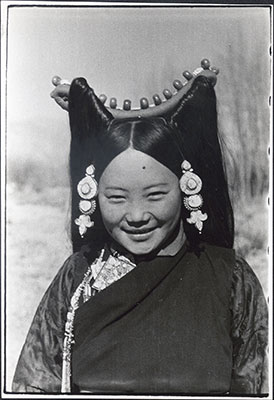
1998.131.417 (Print black & white)


1998.131.417 (Print black & white)

Frederick Spencer Chapman
Frederick Spencer Chapman
January 1st 1937
Lhasa > Dekyi Lingka
1998.131.417
173 x 120
Print gelatin silver
Donated 1994
Faith Spencer Chapman
British Diplomatic Mission to Lhasa 1936-37
Frederick Spencer Chapman
BJ.12 [view film roll]
SC.T.2.417
Notes on print/mount - 'BJ.12' has been written on the back of the print in pencil [MS 24/03/2006]
Manual Catalogues - Caption in Chapman's hand-written list of negatives made whilst on the Mission to Lhasa, 1936-7 [See PRM Manuscripts Collection]: 'Pretty c. [chang] girl v. close - smiling'; PRM Manuscripts Collection: ‘List of Tibetan Prints and Negatives’ - Book 2: ‘ “Rogues Gallery” - 40/2 - A chang girls. A girl of noble family whose job is to pour out the barley beer at official banquets and to see that the guests drink it’ [MS 24/03/2006]
Other Information - Cultural Background: Although Chapman refers to this girl and others like her [see 1998.131.416] as Chang girls who pass out the alcohol at social events, the high quality dress and expensive jewellery they are wearing suggests rather that they are the daughters of aristocratic families who have come along to assist with serving the guests. The women wear their amulets tucked inside their chuba because they are so heavy that they want to prevent the amulet moving around too much or breaking the silk string from which they are suspended. Sometimes beauty spots are made from a sticky gum, which is also supposed to be good for the skin and for health [TS 14/2/2005]
Other Information - Related Images: Images prefixed with 'BJ' comprise a group of negatives containing images of the Lhasa band, chang girls, Tibetan officials including Tsarong and Ringang, Finch, Norbhu, Everest Permit and Khampa people. They all seem to have been taken between January 1st - 7th 1937, with this particular image being taken on January 1st [MS 24/03/2006]
Other Information - Related Images: See 1998.131.416 for a photograph of the young woman in a group of three [MS 24/03/2006]
Other Information - Description: Entry in Mission Diary for January 1st 1936 in which the party was described: "One reason for our feeling of comfort and good cheer was to be found in the activities of the Chang Girls. Normally these girls, resplendent with turquoise ornaments and coral and pearly head-dress, wait on the guests and keep their glasses full of chang. They also force guests to drink by jogging their arms and saying "tunda-ro-nang" (empty it, please). In really obstinate cases they are allowed to use a pin - even on the Prime Minister himself. But on this occasion most of us were drinking whiskey, and once the girls had mastered the art of using a soda-water syphon there was no stopping them; and on more than one occasion they attempted to fill up the glass with neat whisky" ['Lhasa Mission, 1936: Diary of Events', Part XII p.2, written by Chapman] [MS 24/03/2006]
For Citation use:
The Tibet Album.
"Woman at Dekyi Lingka party, New Year 1937"
05 Dec. 2006. The Pitt Rivers Museum.
<http://tibet.prm.ox.ac.uk/photo_1998.131.417.html>.
For more information about photographic usage or to order prints, please visit the The Pitt Rivers Museum.
© The Pitt Rivers Museum